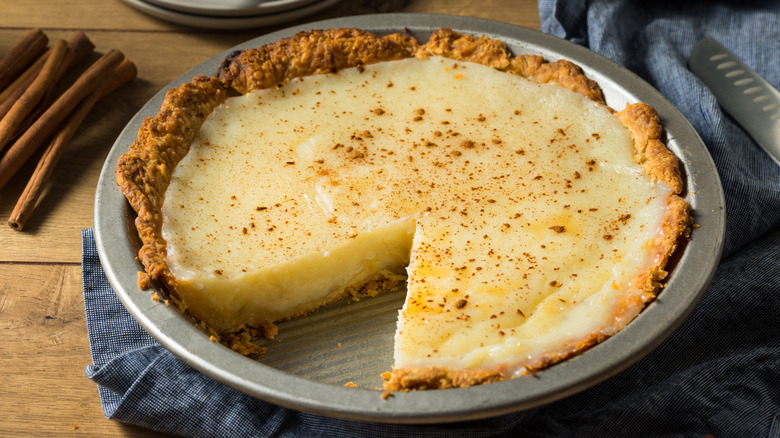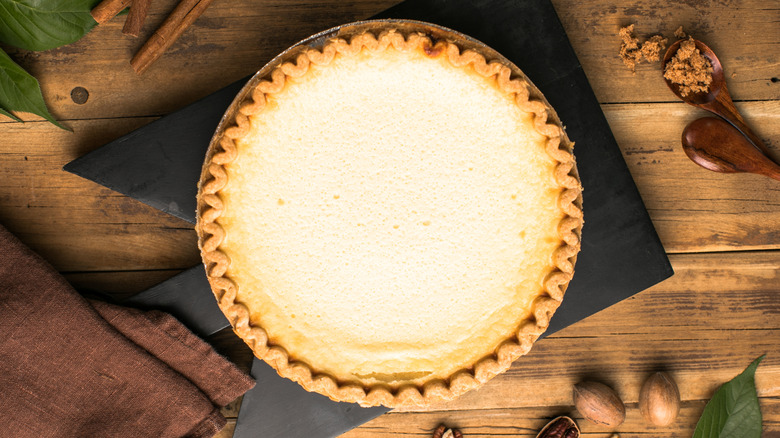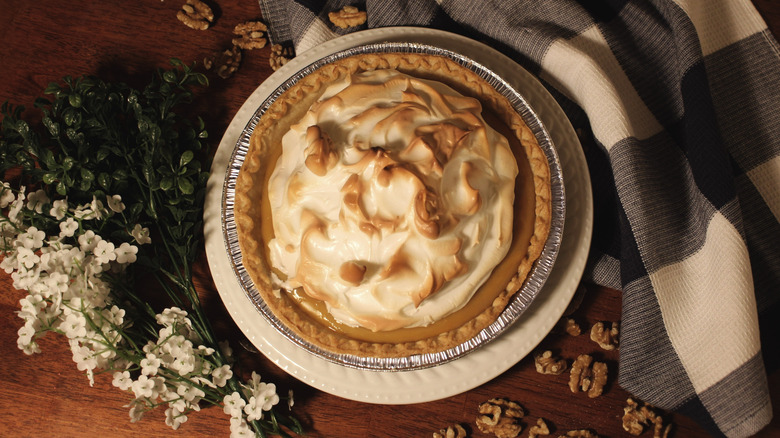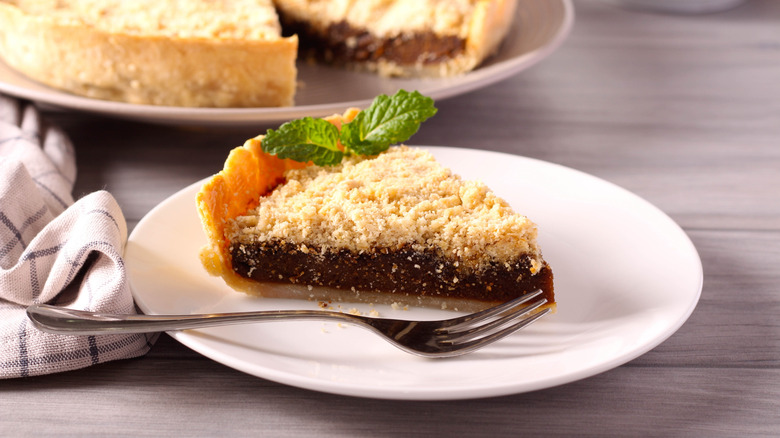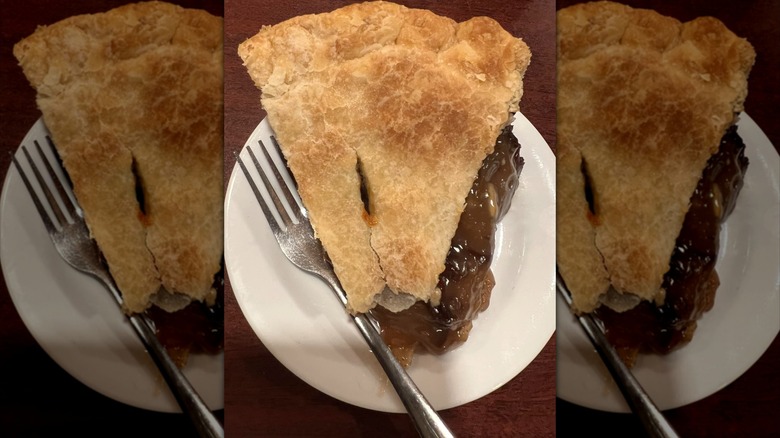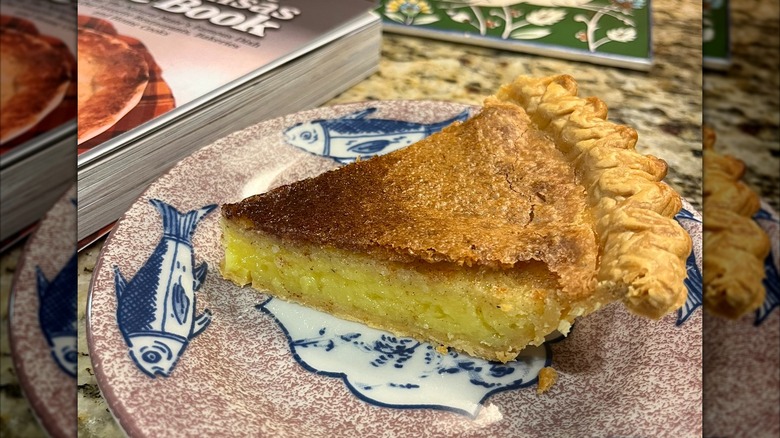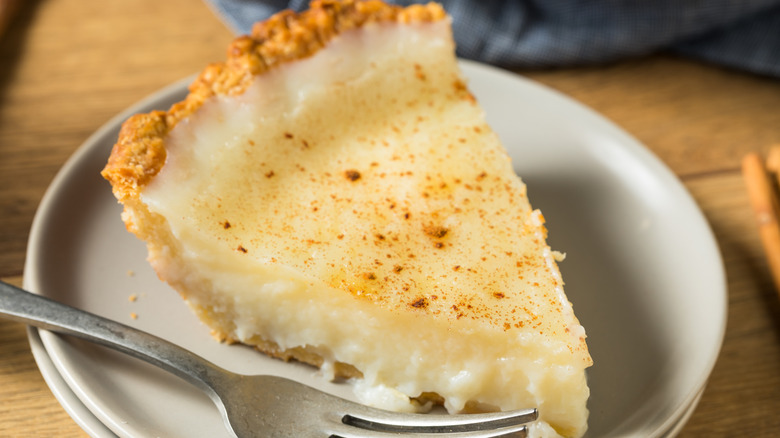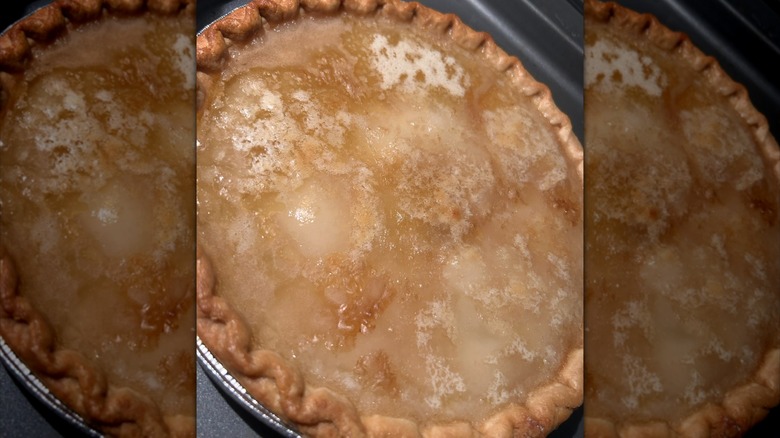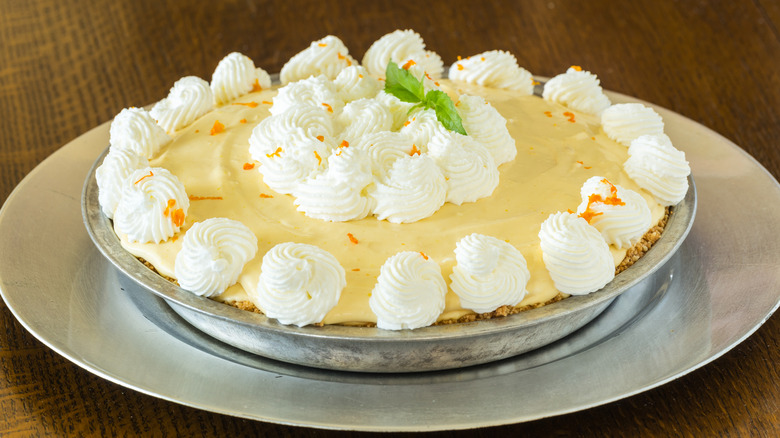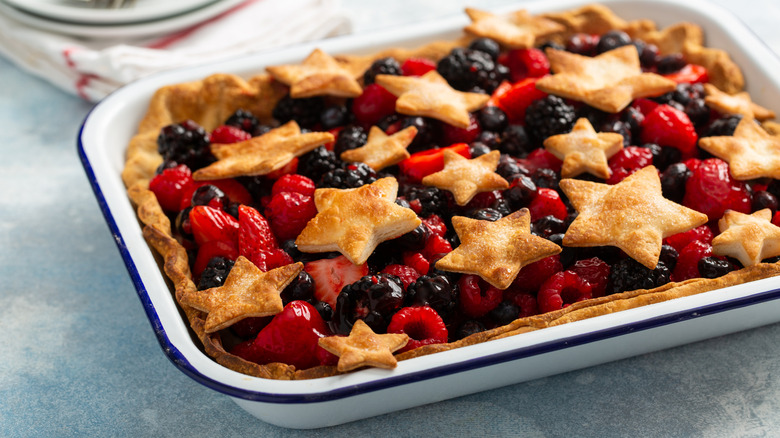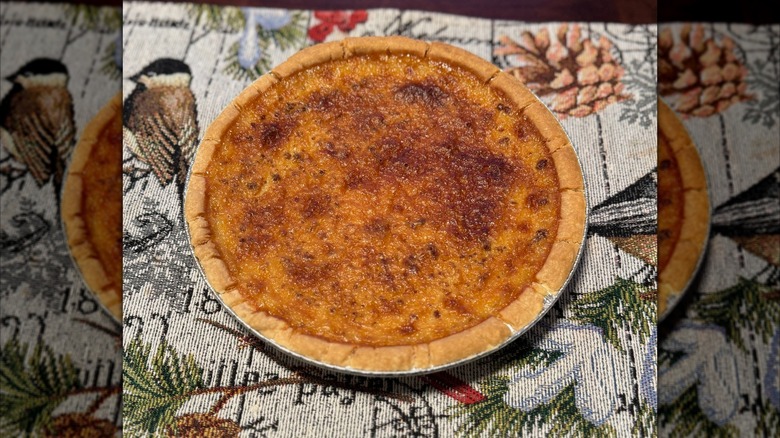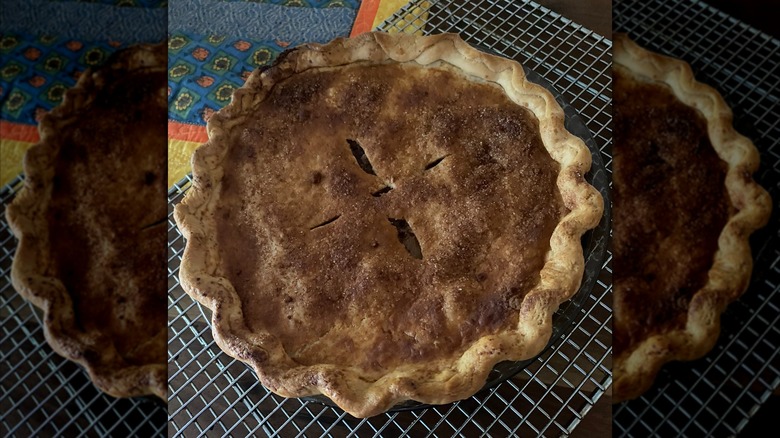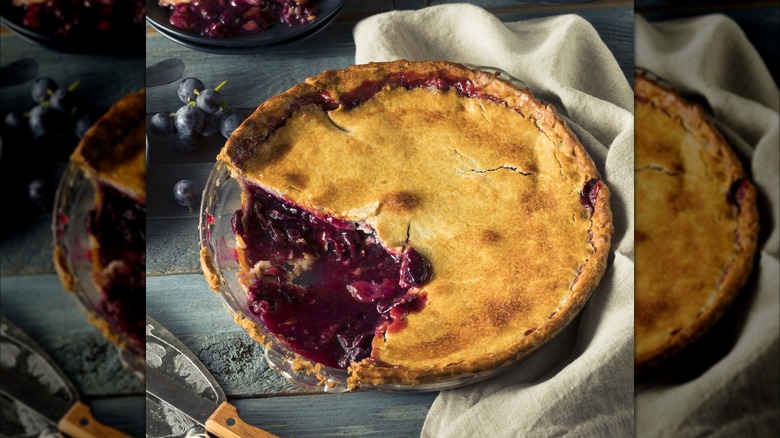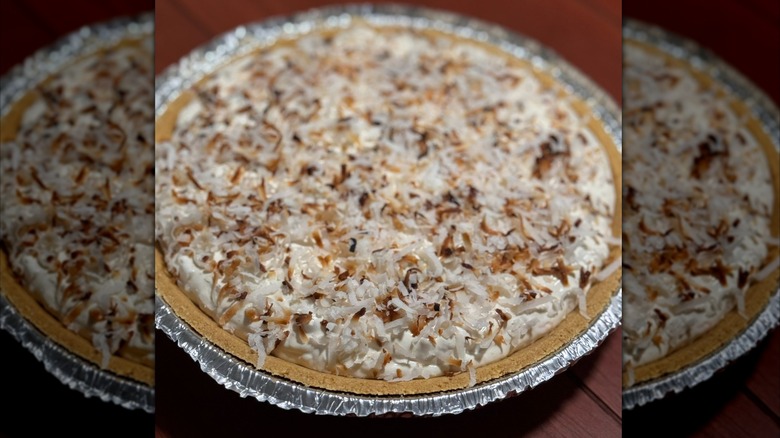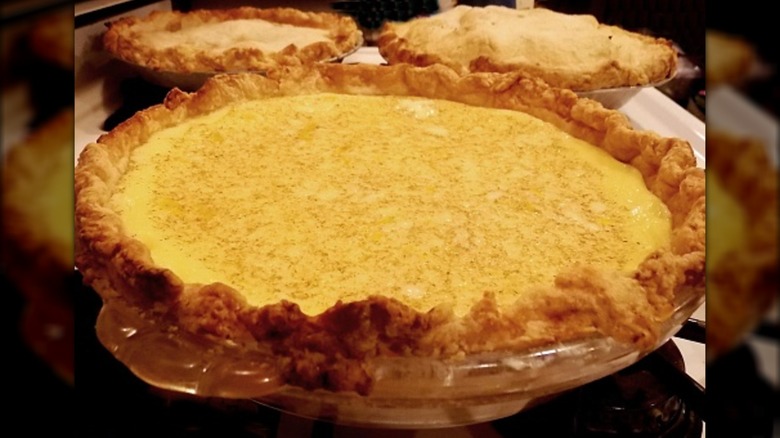Old-School Pie Flavors Almost Everyone Has Forgotten About
Unless you're a hard-core pie aficionado, you likely only eat a few pies per year. Maybe you eat a pumpkin or pecan pie around the holidays, when family members break out favorited secret recipes. Maybe you make a habit each summer of going out and picking your own blueberries or cherries, and then turning them into a delectable dessert. Or maybe you have a hometown diner that reliably serves up the best apple pie you've ever eaten. You've probably loved a handful of pies in your life, but if you're only eating a few different types of pies and only a few times throughout the year, your experience of this comfort food may be sadly limited.
Well, it's time to improve your pie-ducation. There are probably some old-school pie flavors that you know about, but that you don't really think about all that often. When you're considering taking a pie to a potluck or adding something new to the holiday dessert table, you don't even consider these selections. We're going far beyond the coconut cream pies, chess pies, lemon meringue pies, and peach pies that, while not as popular as pumpkin or apple, still find their place on bakery shelves. These are the old-school pie flavors that almost everyone has forgotten about.
Egg custard pie
You probably aren't actively trying to eat custard all that much, but you're also probably eating it more than you think, just under a different name. A custard is technically any dish that combines eggs with milk or cream, before heating the mixture so that it thickens. As such, custard-based dishes you might eat on a regular basis include cheesecake, quiche, and frittata.
That said, most of us still aren't eating egg custard pies all that often. While custard-based pies like chess pie are more familiar, an egg custard pie is a specific type of custard pie that combines just a few ingredients: eggs, sugar, some sort of liquid dairy (it could be half-and-half, heavy cream, milk, or a mix), and salt, plus something for flavor, like nutmeg or vanilla.
The preparation is pretty simple. After pre-baking a flaky, buttery homemade pie crust, you just mix all your custard ingredients, add them to the crust, and then bake until set. While custard-based pies date back centuries, today, you're only likely to stumble upon an egg custard pie if you're lucky — and possibly only if you happen to be traveling through the American South.
Butterscotch pie
You're unlikely to find butterscotch anything nowadays, let alone butterscotch pie. Once a favorite dessert flavor, butterscotch has been by and large replaced by caramel. While similar, there are distinct differences between butterscotch and caramel: The former is made from butter, brown sugar, and cream, while the latter is reliant primarily on white sugar and water, plus lesser portions of butter and cream. While butterscotch dates back to England in the 1800s, butterscotch pie boasts more contemporary, Indiana origins.
The story goes, a mother trying to make a custard allowed a handful of her ingredients to cook for too long. The custard was ruined, but her sons ate the mixture anyway, saying it reminded them of butterscotch candy. Once the mixture was added to a pie crust, butterscotch pie became a staple at the family's series of Indiana restaurants, until they closed in 1969. As butterscotch in general became less of an in-demand flavor, so did butterscotch pie become a less-popular treat.
Shoofly pie
Shoofly pie can still be found at Amish markets throughout Pennsylvania Dutch country, but you may struggle to find it elsewhere. If you're not familiar, shoofly pie, which first came on the scene more than a century ago, is really part-pie, part-cake, with one layer of a sticky molasses filling and another layer that's reminiscent of a crumb cake.
However, how these layers come together will depend on if you're eating a wet bottom or dry bottom shoofly pie. A dry bottom shoofly pie alternates molasses with the cake-layers, making for a dryer, cakier pie. A wet bottom shoofly pie keeps the molasses all on the bottom, with minimal mixing of layers, for a crumby top and a sticky-sweet, toffee-like bottom. It's said that the dry bottom version is the original, authentic shoofly pie.
Whatever your preference, where exactly does the name "shoofly" come from? No, it's not thought that you'll need to "shoo" any flies away from this dessert. Instead, the name most likely refers to a brand of molasses that was popular at the time of the pie's creation.
Raisin pie (or funeral pie)
Whether you call it raisin pie or funeral pie, the consensus is the same. This old-fashioned treat went hand-in-hand with Pennsylvania Dutch funerals. A time-intensive food that kept well, it eventually became less associated with death, and today, you might not even be able to find it in Pennsylvania Dutch communities.
While, if you're one to turn your nose up at oatmeal raisin cookies, you might not care for this pie and it's all-raisin filling (don't worry, there's some sugar and lemon in there, too), if you'd take an oatmeal raisin cookie over chocolate chip any day, then this is a forgotten historic pie that you need to add to your baking repertoire. While you do, be glad that food production has progressed quite a lot since the advent of raisin pie; during the pie's heyday, the raisins would need to be processed by hand, removing the stems and seeds from each grape used.
Vinegar pie
You might love salt and vinegar chips, or malt vinegar sprinkled over your fries or fried fish, but vinegar pie? You really have to love vinegar in order to give this vintage pie a taste. All it contains is sugar, vinegar, and flour, at its most basic, though sometimes you'll also find water, butter, and eggs in the recipe.
While sometimes associated with the Great Depression, vinegar pie was not a symbol of scrappy, desperate baking, but is instead traceable to the mid-1800s, when it was often made with a double crust (today, you're more likely to find it with a single crust). Recipes for vinegar pies showed up in cookbooks and similar publications all through the following decades, before finally seeming to fall out of favor in the mid-20th century. If you like a tart pie, such as a lemon or key lime pie, and you're looking for an easy, quick, and unique dessert recipe, vinegar pie might be worth a try.
Buttermilk pie
Buttermilk pie is very similar to egg custard pie, in that it is a custard pie, at its core, but it specifically calls for buttermilk for the custard's requisite liquid dairy. Traced to the American South, buttermilk pie was popular during lean periods of history, as it required only a handful of ingredients. Even outside of lean years, such as during the Great Depression or wartime, buttermilk pie was a go-to option during the average winter, when access to fresh fruit was limited.
It's often likened to chess pie, another Southern favorite, but buttermilk pie has a slightly different texture (as chess pie may contain cornmeal) and buttermilk pie does have a distinct slightly tart flavor. Meanwhile, the pie's custard-y texture and taste is repeatedly compared to that of crème brulee. So, if you like crème brulee, like chess pie, and like egg custard pie, chances are good that you'll like buttermilk pie, too.
Sugar cream pie
Like butterscotch pie, the state of Indiana claims sugar cream pie as its own. No matter that Indiana residents will also admit that the pie made its way to the state via Quaker settlers from the South. Indiana liked what it saw and thus decided that sugar cream pie would become the unofficial state pie.
If you've plenty of experience living in or knowing folks from Indiana, but you've never heard of sugar cream pie, it's worth noting that this is a pie that goes by many names. It may also be called Hoosier pie, desperation pie, or finger pie. Whatever you call it, the necessary ingredients are minimal, including sugar, cream, butter, and cornstarch. Intrigued? This pie is a little easier to get your hands on than some of the other vintage pies on this list, because Indiana's Wick's Pies produces around 10,000 of these pies per day and you can order a sugar cream pie shipped direct from the bakery, via Goldbelly.
Water pie
Many vintage pies have been given the moniker "desperation pie" due to their limited, cheap ingredients, and their popularity within the Depression Era. However, is there really any pie that sounds as desperate (and, frankly, depressing) as a water pie? And is it any wonder that this sad, once-forgotten pie found a new life during the Covid-19 pandemic, before it was quickly forgotten again?
So what is a water pie? Well, it's just what it sounds like; it's mostly water, but with flour, butter, and sugar. While this pie is often linked with the Great Depression, it dates back further, with recipes for cold water pie making newspaper appearances in the late 1800s, promoted as an alternative to a custard-based pie when dairy was limited.
Unfortunately, the general consensus among most is that this pie has fallen out of favor for good reason. Water mixed with flour, butter, and sugar, is probably just about as tasty as you'd imagine it to be.
Icebox pie
Icebox pie has fallen out of favor much like the word "icebox," but if you're looking for a no-bake, easy-as-pie (pun intended) dessert to make this summer, look no further. This pie deserves a resurgence in popularity.
However, don't make the mistake of thinking that icebox pies didn't make an appearance until the modern refrigerator was invented. Icebox pies actually go back to the early 1800s, when literal iceboxes (basically boxes filled with ice) were used for chilled food storage. Icebox pies were an easy dessert that could be made quickly, with no cooking whatsoever required.
The earliest versions often contained gelatin, to help with the heat-free thickening and setting. Today, you can find a few different flavors of icebox pies, particularly in the South, but perhaps none is as famous as the lemon icebox pie, which requires just lemon, eggs, and condensed milk, and is comparable to a key lime pie in tartness and texture.
Peanut pie
No, we're not talking about a peanut butter pie. That particular pie variety still has a bit of a following. Instead, we're looking at the peanut butter pie's vintage and long-lost cousin, the sweet and crunchy peanut pie.
Recipes for the peanut pie popped up as early as the late 1800s, and the peanut pie enjoyed continued popularity through the mid-20th century. Containing whole peanuts, corn syrup, eggs, vanilla, sugar, and butter, it's best compared to a pecan pie. In fact, at one point, peanut pies were simply known as the poor man's pecan pie.
Today, you'll find peanut pie in limited areas of the country (parts of Virginia, mostly) and modern peanut pie, just like pecan pie, has become more varied, with creative cooks adding extra ingredients, such as chocolate or whiskey, for richer flavors. So, if you want a unique and unexpected alternative to a pecan pie, you've found it.
Slab pie
The name might not be pretty, but when you learn about slab pie, you may just wonder why this ingenious invention ever fell out of favor with the modern home cook. Slab pie isn't as old as a lot of pies on this list, maybe 50 years or older, but the benefits of opting for a slab pie are clear.
Slab pies are baked in slabs, essentially. Imagine that you took your favorite pie and just baked it on a sheet pan. You smooth out your filling in the bottom of the sheet pan (unless you're going for a double-crust pie, in which case you'd first put down your initial layer of dough and pre-bake it), cover the filling with your top pie crust, and bake. Except, because you've spread out a normal pie over a larger, flatter area, the pie bakes faster than normal. Plus, that same width and shortness makes for a shorter cooling time. Not to mention, you can get more slices out of a pie that's a larger rectangle than you can the average circular pie plate — making it the perfect choice for entertaining.
Marlborough pie
Marlborough pie is a bit like apple pie, though slightly different, and a lot more historic. An English invention brought over to the New World, Marlborough pie can be traced to the mid-1600s. The pie also found a place (listed as a pudding) in the first-ever American cookbook, "American Cookery," published in 1796. So what is it? Imagine that a custard-based pie and a traditional apple pie had a baby; that might get you close. A Marlborough pie's single bottom crust supports a custard mixed with cooked apples and lemon juice (which works wonders in apple pie), seasoned with nutmeg and cinnamon.
After the country's founding, Marlborough pie retained its popularity through the 1800s and even to the early 1900s. Today, cooks have tossed out the Marlborough pie in favor of the traditional, double-crust apple pie, possibly due to the overall preference for fruit pies versus custard pies. However, if you can make either, you can make a Marlborough pie — and you might just prefer it.
Mock apple pie
Another variant of apple pie that persisted for some time before falling to the wayside, mock apple pie is yet another pie born out of necessity, created in an attempt at satisfying cravings that went unsatisfied due to lack of ingredients or money. When apples in particular were in short supply, mock apple pie came through. Many say that the original recipe for this pie were popularized by the Ritz Crackers brand, which first appeared in 1934; while Ritz Crackers may have popularized the mock apple pie, though, records of mock apple pie that incorporated soda crackers or stale bread show that bakers were using this method in the 1800s.
In short, Ritz's recipes instructed home cooks to smash up some Ritz crackers and use them in place of apples in their apple pie recipes. It's that simple. The recipes remained somewhat popular for a few decades, but now you'll find few home cooks baking up a mock apple pie, when you can simply go to the nearest grocery store and buy an abundance of apples.
Grape pie
Yes, grape pie and raisin pie are two different types of long-forgotten, once-popular vintage desserts. While raisin pies have Pennsylvania Dutch roots, the grape pie is most associated with the Finger Lakes region of New York, where it's said the pie became popular in the 1950s. (In fact, you can find a historical marker for grape pie located outside the Naples Memorial Town Hall in Naples, New York.)
Making grape pie is no easy task, though, which is why you probably can't find it unless you make a special trip to Naples. A pie can easily require up to two pounds of grapes, and all of them need to be peeled, cooked, and seeded. Don't throw out those peels, though. You'll need them during the cooking process. After the grape filling is ready, the pie basically comes together much like a blueberry pie, with a similar texture and color, and the flavor is distinctively wine-y.
Million dollar pie
As its name suggests, the million dollar pie is a decadent thing. Purportedly created in South Carolina in the 1930s or 1940s, the million dollar pie is technically an icebox pie, as it requires no baking. Instead, you blend whipped cream, condensed milk, pineapple, coconut, and pecans, before filling your pie crust and topping it all with even more whipped cream, and either maraschino cherries or more coconut. Then, you simply toss it into the fridge until you're ready to chow down.
Sometimes, million dollar pie is also called millionaire's pie. Whatever you call it, though, if you want to take this pie to the next level, you can turn it into a billionaire pie, or billion dollar pie, by adding cherry pie filling to the filling mix, making it all the more extravagant (similarly to how you can amp up millionaire's shortbread, turning it into billionaire's shortbread with the addition of salted caramel versus regular caramel).
Pineapple pie
Pineapples were once a luxury, but as pineapples became more popular so did the pineapple pie. Pineapple pie recipes are all fairly similar, calling for shortening or lard-based pie crusts, and a filling made up of primarily sugar, egg, pineapple, and some sort of citrus juice. These pies were popular in Florida in the late 1800s and early 1900s, as Florida was once a leading pineapple producer, and you could still find pineapple pie recipes in cookbooks in the 1920s. It's said that Johnny Cash had a thing for pineapple pie, too.
Today, pineapple pie might not be as much of a staple dessert as apple, cherry, or blueberry pie, but you can still find pineapple pie easily if you have a Philippine bakeshop in your neighborhood. Albeit, these pineapple pies will look slightly different from those that the early Floridians were enjoying. The pie is cut into dough-encased triangles that can easily be eaten by hand.
Grasshopper pie
Retro to the core, the grasshopper pie was derived from an equally retro cocktail, the Grasshopper. The bright green cocktail was supposedly invented in the 1910s. Containing crème de menthe, crème de cacao, and cream, it's a cocktail that's big on flavor, fluffy, and remarkably distinct — just like the pie that later took its name.
Grasshopper pie is an icebox pie that similarly combines crème de menthe, crème de cacao, and cream, but adds in gelatin and eggs, so that the pie can set. Additionally, chocolate is added by way of a chocolate crust and chocolate toppings.
So why aren't grasshopper cocktails and pies currently popular? Well, for many today, they can still remember their parents or grandparents indulging in these treats, making them feel old-fashioned — and the sweet, creamy ingredients certainly make at least the cocktail feel overly heavy. Like some of the other pies on this list, we may just need to wait a few more decades for grasshoppers and grasshopper pies to become popular again.
